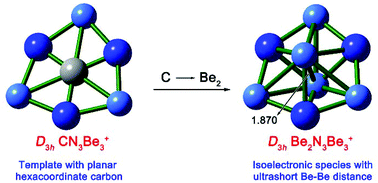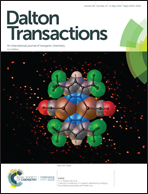Computational design of species with ultrashort Be–Be distances using planar hexacoordinate carbon structures as the templates†
Abstract
A current project in metal–metal bonding chemistry is to achieve ultrashort metal–metal distances (USMMDs, denoted by dM–M < 1.900 Å) between main group metal beryllium atoms. A valid way for achieving such USMMDs is the substitution of a carbon atom in a planar pentacoordinate environment with the isoelectronic Be2 moiety. In the present work, we report our recent findings that a similar substitution can be applied to the carbon atom in a planar hexacoordinate environment. Using species CN3Be3+ and CO3Li3+ and related analogues as the templates, the Be2N3M3+ (M = Be, Mg, Ca) and Be2O3M3+ (M = Li, Na, K) species with axial ultrashort Be–Be distances of 1.627–1.870 Å were designed computationally. The ultrashort Be–Be distances in these species represent a balance between the lengthening effect of axial Be–Be electrostatic interactions and the shortening effects of the strong X–Be bonding and repulsive X–X–X electrostatic interactions. In addition, the shorter axial Be–Be distances were determined firstly by the smaller size of the bridging electronegative X atoms and secondly by the lower electronegativity of the peripheral M atoms, while the stabilities of the newly designed species were closely related to the types of valence electron pairs, whereby the localized two-center two-electron bonds were better for stabilization than the non-bonding valence lone pairs. Among the newly designed species, Be2N3Be3+ and Be2N3Mg3+ were characterized to be the kinetically stable global minima, thereby providing promising targets for the experimental realization of species with USMMDs between main group metals.



 Please wait while we load your content...
Please wait while we load your content...